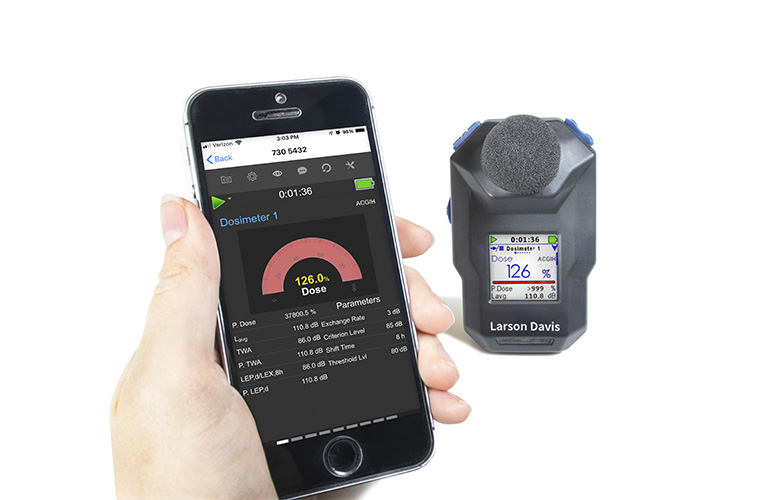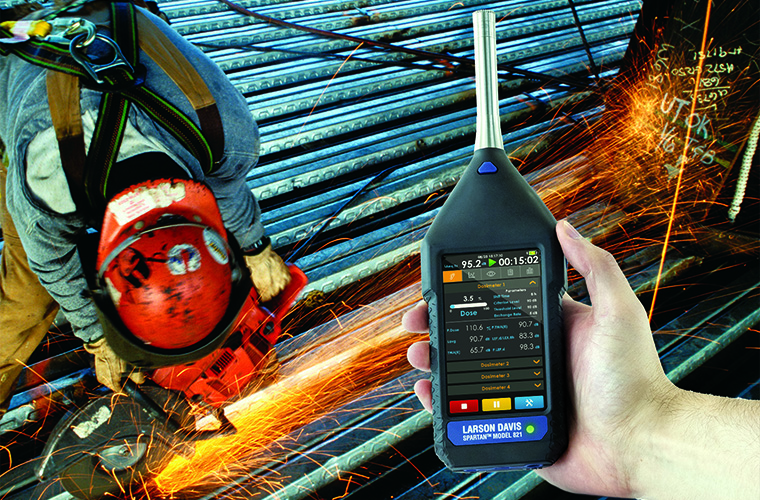Main Menu
- Home
- Products
- Applications
- Product Support
- Service
- Learn
- Product News
- About Us
- Contact Us
 You may have heard that OSHA is renewing emphasis on hearing conservation programs in your area. You may have recently learned an employee is suffering from hearing loss. Maybe you are simply an employer who wants to take good care of your employees.
Whatever your motivation for learning more about the dose of noise experienced by individuals in your facility, we’re here to help. Assessing the level of noise in your workplace is the first step. Understanding the noise level by measuring
your employees’ exposure (known as noise dose) provides the pathway toward mitigating the effects of hazardous noise.
You may have heard that OSHA is renewing emphasis on hearing conservation programs in your area. You may have recently learned an employee is suffering from hearing loss. Maybe you are simply an employer who wants to take good care of your employees.
Whatever your motivation for learning more about the dose of noise experienced by individuals in your facility, we’re here to help. Assessing the level of noise in your workplace is the first step. Understanding the noise level by measuring
your employees’ exposure (known as noise dose) provides the pathway toward mitigating the effects of hazardous noise.
 Noise dose is simply a way to measure the amount of exposure to sound an individual receives in a given time period. At its simplest, it is a function of the noise level experienced and the amount of exposure time. It is expressed in the form of a percentage
of total allowable exposure. If the worker is exposed to varying noise levels throughout the day (perhaps they move around from station to station or different equipment is running at different times), it is convenient to measure noise dose with a
personal noise dosimeter. Without a noise dosimeter, computing overall noise dose for varying noise levels is complicated; due to their logarithmic nature decibel levels cannot be simply averaged.
Noise dose is simply a way to measure the amount of exposure to sound an individual receives in a given time period. At its simplest, it is a function of the noise level experienced and the amount of exposure time. It is expressed in the form of a percentage
of total allowable exposure. If the worker is exposed to varying noise levels throughout the day (perhaps they move around from station to station or different equipment is running at different times), it is convenient to measure noise dose with a
personal noise dosimeter. Without a noise dosimeter, computing overall noise dose for varying noise levels is complicated; due to their logarithmic nature decibel levels cannot be simply averaged.
 The first step when a noise problem in the workplace is suspected is to perform a sound survey. The simplest way to accomplish this is to measure with a handheld, calibrated sound level meter at various locations. Typically, this measurement is made with the Sound Level Meter set to frequency weighting A and time weighting Slow. The sound levels of potential problem
areas may be plotted on a noise survey map. If any area measures over 80 to 85 dB, further investigation is recommended. (If measuring with a less accurate device, for example a cell phone app, consider further measures if the noise level in an area
measures over 75 dB.)
The first step when a noise problem in the workplace is suspected is to perform a sound survey. The simplest way to accomplish this is to measure with a handheld, calibrated sound level meter at various locations. Typically, this measurement is made with the Sound Level Meter set to frequency weighting A and time weighting Slow. The sound levels of potential problem
areas may be plotted on a noise survey map. If any area measures over 80 to 85 dB, further investigation is recommended. (If measuring with a less accurate device, for example a cell phone app, consider further measures if the noise level in an area
measures over 75 dB.)
If an individual worker is stationary all day, a sound level meter can also be used to measure noise levels and calculate dose. A Sound Level Meter designed specifically for the Occupational Health and Safety professional may have built-in functionality to calculate and display noise dose. If the meter does not make the dose calculation, there are methods to calculate dose by hand. However, for anyone moving around to areas with varying noise levels, a personal noise dosimeter, a small badge-type device worn by the employee during a typical work day, is the simplest and least obtrusive option for directly measuring noise dose. A noise dosimeter with built-in bump and motion detection plus sound recording option helps ensure you’re getting data that represents the actual dose being received by the person wearing it
Allowable noise dose is not universally agreed upon. There are unique standards in place in the EU, the US, Canada, Australia, and elsewhere. Zero represents no exposure and 100 or more represents “complete” exposure, but that 0-100 means something different depending on which standard is being used for measurement. Each standard makes certain assumptions, including:
What does this mean to you? When measuring with a personal noise dosimeter, all you need to know is the specific noise standard for your location or situation. In the United States, most workplaces are obligated to comply with OSHA-PEL noise exposure limit. In Europe, workplace noise falls under EU Directive 2003/10/EC. Larson Davis’ Spartan™ Workplace Noise Dosimeter makes it easy to comply with a wide variety of standards including
Although you may be required to comply with a less conservative standard such as OSHA-PEL, there is ample evidence that a daily noise dose much lower than allowable by OSHA-PEL can damage hearing. For example, the professional association American Conference of Governmental Industrial Hygienists (ACGIH) makes its own recommendations via their standard. Spartan Noise Dosimeters allow you to measure to several standards at once with its four virtual dosimeter displays. Consider looking at the data from several different measurement standards to better understand the wide range of levels considered legal, safe, or acceptable.

Results are displayed as a percentage indicating how much of the employee’s daily allowable noise dose they received during the measurement. If the measurement period was less than a typical workday, the P.Dose (projected dose) indicates how much dose that individual would receive over a full work day if the pattern of noise continued all day. Following is an example of what the screen of your mobile device displays during data collection. Note that up to four virtual dosimeters measure and display results at a time.

OSHA-PEL Dose

OSHA-HC Dose

ACGIH Dose

NIOSH Dose
The critical information is the standard used and the percent dose, both clearly displayed on your screen and in reports. You can learn more about some of the other parameters displayed by looking at our Noise Dosimetry Glossary.
Making Reports: With a few clicks in the app, easily generate and email a pdf report of results.

If your measurement finds that employees in your facility are experiencing an unsafe dose of noise, the next step is to implement a plan.